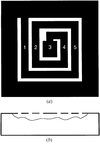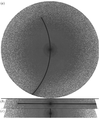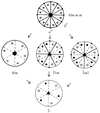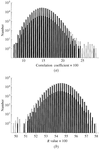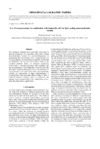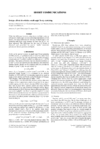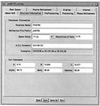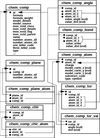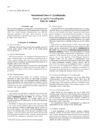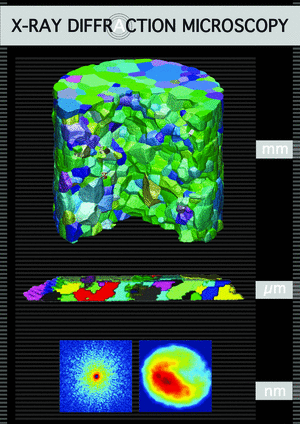issue contents
February 1999 issue

Cover illustration: Simulated diffraction pattern for a two-dimensionally disordered decasil (porous SiO2) calculated using a fast recursive algorithm. The plane is perpendicular to c with the reciprocal index l = 1; the error probability is 0.5 and the intensities are scaled to 25% of the highest value. Courtesy of Peter Daniels.
research papers
The origins of pyroelectricity and ionic conductivity on an atomic scale are described using results from accurate X-ray diffraction analyses, at several temperatures, of the electron-density distribution.
A simple algorithm is proposed for quantifying and correcting geometric distortions introduced by fiber-optic tapers in an X-ray CCD detector with direct taper coupling.
The conformation of the macrocyclic [2+2] dimer formed from 4,4′-dichlorodiphenyl sulfone and bisphenol-A has been determined in the unsolvated material and in the dimethyl sulfoxide solvate. Intermolecular phenyl–plenyl stacking interactions are apparently important in determining the conformation in the solid state.
The conditions for calculating the parent texture from the inherited texture in the β–α transformation are discussed. The use of a specific correlation function allows information to be gained in the case of variant selection.
Using the Houska method based on X-ray diffraction-line profile analysis, new mathematical treatments are proposed to compute the concentration depth profile of thin films obtained by diffusion. Concentration depth profiles of a brass layer are reported.
Free 

A set of general guidelines for structure refinement using the Rietveld (whole-profile) method has been formulated by the IUCr Commission on Powder Diffraction. The practical rather than the theoretical aspects are discussed.
A new weight function for the minimization function used in the Rietveld method has been applied to the determination of site occupancy under various refinement conditions. The accuracy of refined site-occupancy parameters of Mg2−xMnxSiO4 was comparable to that obtained in single-crystal studies.
High-resolution X-ray diffraction study of coiled membrane sensors has revealed in-built stresses, manifested as tilts between different segments of the sensor, and the morphology of the cavity below the membrane. The degree of crystalline perfection of the membrane has been determined.
An improved method of calibrating disk-like image-plate systems is shown to dramatically reduce systematic errors in structure factors and refined protein models.
Three variations of the Porod-law model have been applied to the small-angle scattering from craze-fibril structures. It was determined that the sigmoidal-gradient model of diffuse boundaries provides the best description of these oriented rod-like structures.
Nanosecond time-resolved X-ray diffraction measurements of Pt(111) transient lattice spacing induced by laser heating are described.
The direct methods sum function is adapted to cope with data from powder patterns with systematic overlap. In contrast to usual two-stage procedures, both multiplet decomposition and phase refinement are carried out simultaneously.
A six-dimensional molecular-replacement search has been implemented using Perl scripts to drive the AMoRe translation function and to analyze the results.
cryocrystallography papers
Use of cryoprotectants in combination with immiscible oils for flash cooling macromolecular crystals
The high concentration of cryoprotectant needed to prevent ice formation during cooling to cryogenic temperatures sometimes damages the fragile crystals it is supposed to protect. The described combination procedure permits the successful flash cooling at greatly reduced concentration of cryoprotectant.
A new method for glutaraldehyde cross-linking of protein crystals is presented. The introduction of intermolecular cross-links serves to prevent lattice disorder of fragile crystals during rapid-cooling procedures.
short communications
The importance of recognizing the difference between H2O and D2O solvents for SAXS is discussed.
computer programs
The program SIR97 is a versatile tool for direct solution and complete refinement of crystal structures.
A new version (v2.0) of the direct-methods program SnB is described. SnB v2.0 has been successfully applied to a structure containing 1000 unique non-H atoms and a Se substructure with 30 anomalous sites.
CIF applications
Free 

A new ligand and monomer object data environment named A La Mode is described for building chemical-component models in the mmCIF representation from surveys of high-resolution small-molecule crystal structures. Examples of the application of this system are presented for an intercalating drug component and for a nucleotide unit constructed from independent base, sugar and phosphate constituents.
laboratory notes
Sealing with oil plugs was used as a means to prevent condensation problems in the collection of X-ray diffraction data at 277 K with capillaries cooled by a gas stream from a cryocooler.
international union of crystallography
Free 



 journal menu
journal menu

















